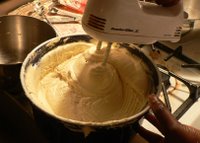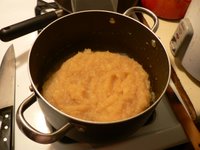
I stole this recipe from "The Complete Asian Cookbook" (5th ed.) by Charmaine Solomon. I took a peek online and it seems there is a modern version of this book; mine is from '82, hard bound and has lots of retro photography. Frankly I'm curious and may have to buy the current version.
Anyhow this dish has become one of my old standbys; it really is delicious if you're open minded enough to eat pork with your hands. There are only a few areas in which I tweak the recipe. I sometimes use maltose for the honey. Rice maltose is traditionally used in glazing Peking Duck; many recipes in books that substitute the more esoteric Asian ingredients call for honey. Maltose is much cheaper and I like to think it is more authentic.
Another area which I tweak is cooking time. The recipe calls for an hour of cooking, I double that at a minimum. I simply find that the fat needs more time to render and become tender; essential for this type of dish.
I also like to substitute one tablespoon of dark soy sauce for light soy sauce. I find when trying to achieve deep, rich flavour and dark brown colour dark soy sauce helps tremendously. Let me also mention
light soy sauce. I am not referring to low sodium soy sauce;
never use this abomination. If you must cut back on your sodium intake then use it only to season food that has been cooked (eg white rice); under no circumstances should it be used for cooking. The 'light' refers to colour and flavour, contrasting from the 'dark' soy sauce (whose most common form is mushroom soy sauce). In general when Asian recipes call for soy sauce they refer to the light version.
You may have trouble finding small cut ribs. If you have a heavy cleaver (I use a 6$ stainless steel monster I picked up in Chinatown) and a good cutting board (I've split the thin ½ inch ploy boards) it's really easy to cut them yourself. If you're not shy you can ask the butcher to do it for you. They can run them through their band saws; very quick and a standard service. I prefer to cut them myself since a whole piece is cheaper (and its fun).
If you decide to cut them yourself (a process known as fabrication) simply cut the ribs top to bottom between the bones. Next cut each bone with a cleaver; you're looking for pieces about ¾ of an inch long. If you position the rib thin side up it will be easier to cut. Also if you don't go all the way through try turning it over and snapping it or another, lighter, hack will make quick work of it.
There are two methods of cooking these ribs; stove top or in the oven. I have always cooked them on the stove until today. I finally bought a roasting pan after a terrible experience browning lamb bones and mirepoix on jelly roll pans. I must say that I've been more than happy with the stove top results. However I now prefer the oven method; it is much easier since the stovetop method usually occupies two burners. In the oven I easily had enough room, even for a double batch.
Ingredients:
3 lbs Pork Ribs
4 Garlic Cloves
1½ t Salt
½ t Black Pepper
½ t Five Spice Powder
1 T Maltose
1 T Roasted Sesame Oil
2 T Light Soy Sauce
1 T Dark Soy Sauce
½ C hot water or stock
- Crush and coarsely chop the garlic on top of the salt.
- Add all ingredients except for the stock into a bowl or roasting pan; mix well. I often let then marinate for as much as 30 minutes to over night although results are still delicious without.
- Cook in oven in roughly a single layer at 350°F for 30 minutes.
- Add the stock and mix. Cook for another 1:30 hours or until brown and tender. Mix occasionally, say about every 20 minutes.
If cooking on the stove top:
- Follow steps 1 & 2 as above.
- Brown the ribs in a heavy large pan over medium high heat.
- Add stock and bring to a simmer. Reduce heat and cook, half covered.
- Stir well every 20 minutes or so until ribs are deeply coloured and very tender; about 1:30 hours. If ribs run dry of liquid (other than fat) add some stock or water otherwise they will burn.
I would further recommend utulizing the sauce; especially if the ribs are being eaten later or another day. Usually we can't keep our hands out of them once they are finished.
- Remove the ribs from the pan.
- Deglaze the pan with stock.
- Strain the resulting sauce into a tallish container.
- Let stand or store in the fridge; then degrease.
- Serve the ribs reheated with the sauce.
 We're baking a decadent desert tonight. It's in honour of my brothers immanent arrival scheduled for tomorrow evening. We'll try to save him some.
We're baking a decadent desert tonight. It's in honour of my brothers immanent arrival scheduled for tomorrow evening. We'll try to save him some.




